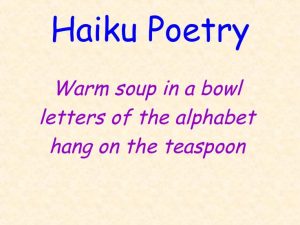
Timeline Of Nick’s Life In Poetry
There are poets and visionaries—souls who write to reveal the truth hidden in the ordinary,
Check out our store for the latest sales and promotions

Haiku might look simple—just three lines and a few syllables, right? But anyone who’s ever tried to write one knows the truth: haiku is a deceptively difficult art form. These tiny poems pack a powerful emotional and sensory punch, and getting them right requires more than just counting syllables.
If you’ve ever felt frustrated trying to make your haiku feel authentic, evocative, or even just coherent, you’re not alone. Most poets, from beginners to seasoned writers, face a number of challenges when first approaching this form.
At the Writers House in Waterfront South, part of the NVHA’s mission is to guide poets of all ages toward deeper, more meaningful expression through poetry—including haiku. In this post, we’re going to explore haiku writing mistakes that many writers stumble over and, more important, how to avoid them. Whether you’re new to the genre or looking to refine your craft, this post is for you.
When many people start writing haiku, they focus almost obsessively on getting the 5-7-5 syllable count just right. And yes, that’s part of it—but not the heart of it. One of the biggest “haiku writing mistakes” is letting structure overshadow substance. In English, syllables don’t quite mirror the sound units (called “on”) used in Japanese haiku. So a rigid focus on 5-7-5 can lead to forced phrasing and awkward language.
Before worrying about form, learn the basics before diving into common pitfalls—like capturing a fleeting moment, a seasonal reference (kigo), and the use of a kireji (cutting word or pause). A haiku isn’t just about structure—it’s about insight, emotion, and clarity. Consider this famous haiku by Matsuo Bashō:
An old silent pond…
A frog jumps into the pond—
Splash! Silence again.
Simple. Still. And unforgettable. You feel the moment because it breathes.
Another common haiku error is writing something that sounds nice but says nothing. A haiku should transport the reader to a moment in time, using vivid imagery and emotional resonance. When a haiku lacks a sensory trigger—what you see, hear, feel, smell, or taste—it loses impact.
Here’s a weak example:
Happiness in spring
Life is full of joy and light
Everything feels right
While sweet, this reads more like a Hallmark card than a haiku. There’s no grounded moment. No image. No breath.
Compare that to:
First crocus opens
in the morning frost—
child’s gasp
Now we’re talking. There’s emotion rooted in a specific scene. If you’re struggling with imagery, see how haiku masters perfected the form—study their attention to nature, emotion, and observation.
It’s tempting to spell everything out when writing poetry. But haiku thrives on subtlety. A common mistake is over-explaining the emotion or message instead of allowing the reader to experience it naturally. This stems from a misunderstanding of haiku’s purpose—it’s not meant to preach or narrate. It’s meant to present.
Bad haiku example:
I lost my father
My heart aches every morning
Sadness never ends
This may be deeply personal, but it reads more like a journal entry. Try instead to let the emotion rise through the image:
His old coat still hangs—
faint scent of pipe smoke lingers
in the morning cold
No mention of grief. Yet we feel it. The power of haiku lies in the space between the words.
Traditional haiku requires seasonal sensitivity, which is frequently lacking in English translations. A kigo is a symbol that conveys an entire emotional and cultural milieu, not just a word used to identify a season. A cherry blossom is a transient beauty, not merely a flower. Snow is more than just cold; it also represents solitude, quiet, and stillness.
In order to check a box, many newcomers either completely ignore this or choose a random weather phrase. However, selecting the appropriate kigo changes your haiku. Here’s an example:
Cicadas buzz loud
sidewalk cracked with summer heat
no breeze in the shade
You feel the season, the stillness, the exhaustion of summer. If you’re unsure how to use seasonal references effectively, compare haiku with other poetic structure—you’ll see how few forms rely on seasonal rhythm the way haiku does.
Classic haiku features a kireji, or “cutting word,” that separates two images or ideas, creating a kind of tension or comparison. English haiku doesn’t have a direct equivalent, but punctuation or line breaks often serve the same purpose.
Without this cut or turn, haiku can feel like simple observations rather than something profound.
Weak example:
Raindrops fall today
puddles form on the sidewalk
I step in a few
This is fine, but flat. Now try:
Raindrops fall again—
a child leaps through the puddles
barefoot and laughing
That dash acts as the cut, setting the stage for something joyful. Following haiku rules like juxtaposition adds movement and meaning to your work.
Another haiku writing mistake is drifting into abstraction or metaphor. Haiku isn’t about grand ideas like “freedom” or “truth”—it’s about a moment in time that points to something deeper. Don’t try to be clever. Be present.
Avoid:
Freedom flies away
like a dove from the prison—
I must chase my dreams
Instead:
Empty swings at dusk—
wind rattles the playground gate
no children today
That’s real. That’s haiku. If you’re unsure, join a workshop to sharpen your haiku skills. Nothing refines your voice like reading with others and learning through community, like the welcoming spaces offered at Writers House in Waterfront South.
Haiku should read like a whisper, not a lecture. Many writers overload their poems with descriptive language to sound poetic, but that usually does the opposite. Words should earn their place.
Clunky haiku:
The crimson cardinal,
perched majestically above
in solemn silence
Better:
Red bird in bare tree—
wind shifts snow from a low branch
then quiet again
Simple. Still powerful. That’s what haiku does best.
Haiku may be small in size, but it carries the weight of a full experience. Whether you’re just starting out or revisiting this form with new eyes, avoiding common haiku errors can open doors to deeper creativity. Remember—learn the basics before diving into common pitfalls, pay attention to seasonal depth, imagery, and that essential “cut,” and keep your language clean and grounded.
At NVHA’s Writers House, we know that poetry—especially haiku—isn’t just an art form; it’s a way to reconnect with the world and ourselves. That’s why we host readings, school classes, and haiku workshops in person and available across the USA and abroad digitally to help poets find their voice. So the next time you write a haiku, slow down, breathe, observe, and let the moment write itself through you.
Join a workshop to sharpen your haiku skills and share your voice. There’s a world of wonder in just three lines—let’s write it together.

There are poets and visionaries—souls who write to reveal the truth hidden in the ordinary,

New Jersey’s Camden. A city that had been a titan of shipbuilding and industry, more

Words that will reverberate over time were once written by a quiet voice amid the
Copyright © 2025 Nick VIrgilio Haiku Association. All rights reserved.

Alfred taught English to junior and senior high school students in New Jersey and Massachusetts prior to working for the municipal government of the City of Camden, New Jersey. He began working with the City of Camden Department of Planning & Development, Division of Housing Services, as a Cost Estimator for Property Improvement in 1984.
He spent the next thirty-eight years working in both the Division of Housing Services, and the Finance Department Bureau of Grants Management, helping the City administer state and federally funded affordable housing projects in Camden.
Alfred spent ten years working with the Bureau of Grants Management, where he reviewed and evaluated grant applications and proposals for funding from non-profit and for- profit housing developers. These agencies included St. Joseph’s Carpenter Society, Heart of Camden, Camden County OEO, Habitat for Humanity,
Camden Lutheran Housing, RPM Development and others. He also worked with social service agencies such as Dooley House, Respond Inc., Sikora House, Center for Family Services, and Volunteers of America, that applied for grant funding.
He also played a significant role in the planning and implementation of the Annual Consolidated Plan grant application submitted to the Department of Housing and Urban Development each year. The Bureau holds an annual grant funding seminar along with public meetings and technical assistance sessions concerning the C-Plan.
Working for the City of Camden Division of Housing Services Alfred also served as the coordinator of the federal funded HOPWA housing Program for 14 years.
HOPWA funds provided safe, affordable, secure, housing for persons with HIV/AIDS, by issuing housing vouchers to their participants. He managed the delivery of services to 80-90 clients a year, covering Camden, Burlington and Gloucester counties.
During his time working for the City of Camden Mr. Dansbury was a member of the CPAC Homeless Network Planning Committee, the Local Law Enforcement Block Grant Advisory Committee and United Neighbors of Whitman Park.
Outside of his work with the City of Camden, Alfred worked as an Adjunct Instructor of Reading Skills and Writing Skills at Camden County College, teaching at both the Camden and Blackwood campuses. In 2022 Alfred published,
“The Strength of Courage” a novel he embarked on as a graduate student in Rowan University’s M.A. in Writing program in 2014-2018.
He earned a Bachelor of Arts in English and Journalism from Rutgers University, a Master’s of Arts degree in Business Administration from Eastern University, a Master’s of Arts in Education from Eastern Michigan University and a Master’s of Arts in Writing from Rowan University.